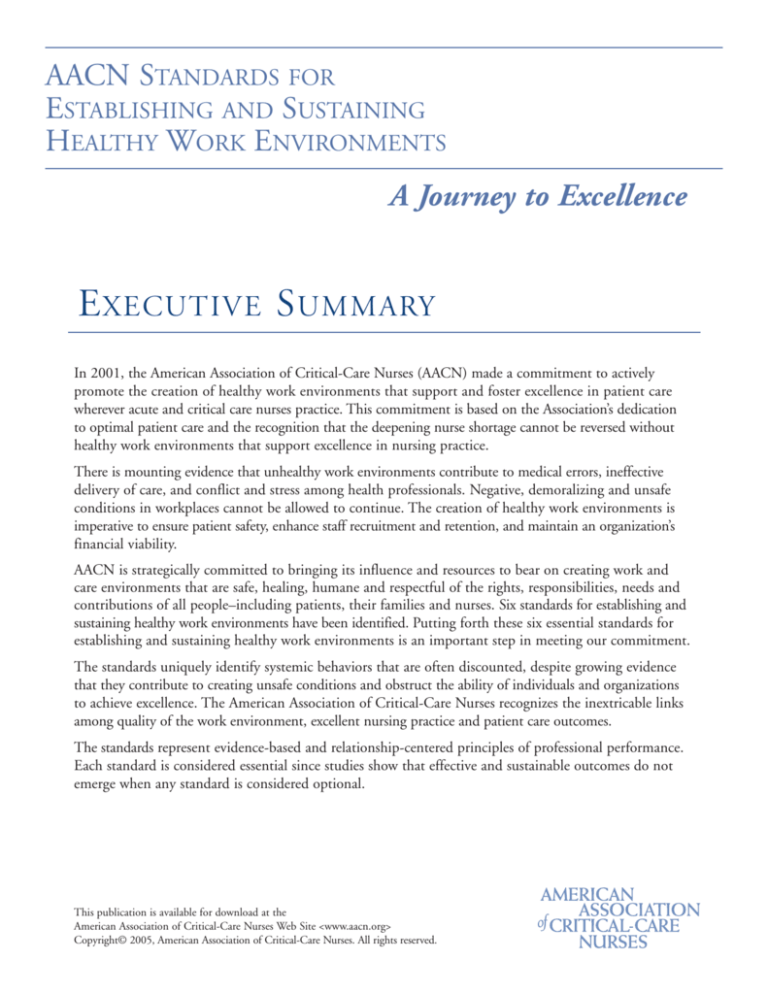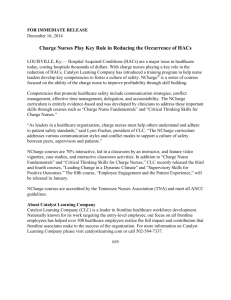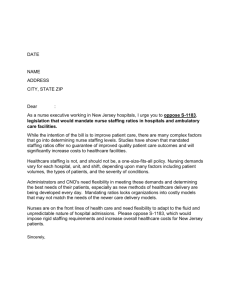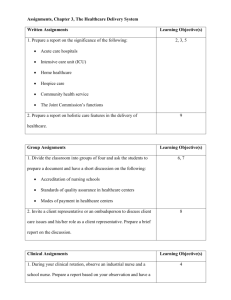
AACN STANDARDS FOR
ESTABLISHING AND SUSTAINING
HEALTHY WORK ENVIRONMENTS
A Journey to Excellence
E XECUTIVE S UMMARY
In 2001, the American Association of Critical-Care Nurses (AACN) made a commitment to actively
promote the creation of healthy work environments that support and foster excellence in patient care
wherever acute and critical care nurses practice. This commitment is based on the Association’s dedication
to optimal patient care and the recognition that the deepening nurse shortage cannot be reversed without
healthy work environments that support excellence in nursing practice.
There is mounting evidence that unhealthy work environments contribute to medical errors, ineffective
delivery of care, and conflict and stress among health professionals. Negative, demoralizing and unsafe
conditions in workplaces cannot be allowed to continue. The creation of healthy work environments is
imperative to ensure patient safety, enhance staff recruitment and retention, and maintain an organization’s
financial viability.
AACN is strategically committed to bringing its influence and resources to bear on creating work and
care environments that are safe, healing, humane and respectful of the rights, responsibilities, needs and
contributions of all people–including patients, their families and nurses. Six standards for establishing and
sustaining healthy work environments have been identified. Putting forth these six essential standards for
establishing and sustaining healthy work environments is an important step in meeting our commitment.
The standards uniquely identify systemic behaviors that are often discounted, despite growing evidence
that they contribute to creating unsafe conditions and obstruct the ability of individuals and organizations
to achieve excellence. The American Association of Critical-Care Nurses recognizes the inextricable links
among quality of the work environment, excellent nursing practice and patient care outcomes.
The standards represent evidence-based and relationship-centered principles of professional performance.
Each standard is considered essential since studies show that effective and sustainable outcomes do not
emerge when any standard is considered optional.
This publication is available for download at the
American Association of Critical-Care Nurses Web Site <www.aacn.org>
Copyright© 2005, American Association of Critical-Care Nurses. All rights reserved.
The standards align directly with the core competencies for health professionals recommended by the
Institute of Medicine. They support the education of all health professionals “to deliver patient-centered
care as members of an interdisciplinary team, emphasizing evidence-based practice, quality improvement
approaches, and informatics.” With these standards, AACN contributes to the implementation of elements
in a healthy work environment articulated in 2004 by the 70-member Nursing Organizations Alliance.
The standards further support
the education of nurse leaders to
acquire the core competencies of
self-knowledge, strategic vision,
risk-taking and creativity, interpersonal and communication
effectiveness, and inspiration
identified by the Robert Wood
Johnson Executive Nurse
Fellows Program.
The standards are neither
detailed nor exhaustive. They do
not address dimensions such as
physical safety, clinical practice,
clinical and academic education
and credentialing, all of which are
amply addressed by a multitude
of statutory, regulatory and professional agencies and organizations.
essential
Absolutely required; not to be used
up or sacrificed. Indispensable.
Fundamental.
standard
Authoritative statement articulated
and promulgated by the profession,
by which the quality of practice,
service or education can be judged.
critical
elements
Structures, processes, programs and
behaviors required for a standard to
be achieved.
The standards are designed to be used as a foundation for thoughtful reflection and engaged dialogue
about the current realities of each work environment. Critical elements required for successful implementation
accompany each standard. Working collaboratively, individuals and groups within an organization should
determine the priority and depth of application required to implement each standard.
The standards for establishing and sustaining healthy work environments are:
Skilled Communication
Nurses must be as proficient in communication skills as they are in clinical skills.
True Collaboration
Nurses must be relentless in pursuing and fostering true collaboration.
Effective Decision Making
Nurses must be valued and committed partners in making policy, directing and evaluating
clinical care and leading organizational operations.
Appropriate Staffing
Staffing must ensure the effective match between patient needs and nurse competencies.
Meaningful Recognition
Nurses must be recognized and must recognize others for the value each brings to the work
of the organization.
Authentic Leadership
Nurse leaders must fully embrace the imperative of a healthy work environment, authentically
live it and engage others in its achievement.
2
standard 1
Skilled Communication
Nurses must be as proficient in communication skills as they are in clinical skills.
critical elements
• The healthcare organization provides team members with support for and access to education
programs that develop critical communication skills including self-awareness, inquiry/dialogue,
conflict management, negotiation, advocacy and listening.
• Skilled communicators focus on finding solutions and achieving desirable outcomes.
• Skilled communicators seek to protect and advance collaborative relationships among colleagues.
• Skilled communicators invite and hear all relevant perspectives.
• Skilled communicators call upon goodwill and mutual respect to build consensus and arrive at
common understanding.
• Skilled communicators demonstrate congruence between words and actions, holding others accountable
for doing the same.
• The healthcare organization establishes zero-tolerance policies and enforces them to address and eliminate
abuse and disrespectful behavior in the workplace.
• The healthcare organization establishes formal structures and processes that ensure effective information
sharing among patients, families and the healthcare team.
• Skilled communicators have access to appropriate communication technologies and are proficient in their use.
• The healthcare organization establishes systems that require individuals and teams to formally evaluate
the impact of communication on clinical, financial and work environment outcomes.
• The healthcare organization includes communication as a criterion in its formal performance appraisal
system and team members demonstrate skilled communication to qualify for professional advancement.
3
standard 2
True Collaboration
Nurses must be relentless in pursuing and fostering true collaboration.
critical elements
• The healthcare organization provides team members with support for and access to education
programs that develop collaboration skills.
• The healthcare organization creates, uses and evaluates processes that define each team member’s
accountability for collaboration and how unwillingness to collaborate will be addressed.
• The healthcare organization creates, uses and evaluates operational structures that ensure the decision
making authority of nurses is acknowledged and incorporated as the norm.
• The healthcare organization ensures unrestricted access to structured forums, such as ethics committees,
and makes available the time needed to resolve disputes among all critical participants, including
patients, families and the healthcare team.
• Every team member embraces true collaboration as an ongoing process and invests in its development
to ensure a sustained culture of collaboration.
• Every team member contributes to the achievement of common goals by giving power and respect to
each person’s voice, integrating individual differences, resolving competing interests and safeguarding
the essential contribution each must make in order to achieve optimal outcomes.
• Every team member acts with a high level of personal integrity.
• Team members master skilled communication, an essential element of true collaboration.
• Each team member demonstrates competence appropriate to his or her role and responsibilities.
• Nurse managers and medical directors are equal partners in modeling and fostering true collaboration.
4
standard 3
Effective Decision Making
Nurses must be valued and committed partners in making policy, directing
and evaluating clinical care and leading organizational operations.
critical elements
• The healthcare organization provides team members with support for and access to ongoing education
and development programs focusing on strategies that assure collaborative decision making. Program
content includes mutual goal setting, negotiation, facilitation, conflict management, systems thinking
and performance improvement.
• The healthcare organization clearly articulates organizational values and team members incorporate
these values when making decisions.
• The healthcare organization has operational structures in place that ensure the perspectives of patients
and their families are incorporated into every decision affecting patient care.
• Individual team members share accountability for effective decision making by acquiring necessary
skills, mastering relevant content, assessing situations accurately, sharing fact-based information,
communicating professional opinions clearly and inquiring actively.
• The healthcare organization establishes systems, such as structured forums involving all departments
and healthcare disciplines, to facilitate data-driven decisions.
• The healthcare organization establishes deliberate decision making processes that ensure respect for
the rights of every individual, incorporate all key perspectives and designate clear accountability.
• The healthcare organization has fair and effective processes in place at all levels to objectively
evaluate the results of decisions, including delayed decisions and indecision.
5
standard 4
Appropriate Staffing
Staffing must ensure the effective match between patient needs and nurse competencies.
critical elements
• The healthcare organization has staffing policies in place that are solidly grounded in ethical principles
and support the professional obligation of nurses to provide high quality care.
• Nurses participate in all organizational phases of the staffing process from education and
planning–including matching nurses’ competencies with patients’ assessed needs–through evaluation.
• The healthcare organization has formal processes in place to evaluate the effect of staffing decisions on
patient and system outcomes. This evaluation includes analysis of when patient needs and nurse competencies
are mismatched and how often contingency plans are implemented.
• The healthcare organization has a system in place that facilitates team members’ use of staffing and
outcomes data to develop more effective staffing models.
• The healthcare organization provides support services at every level of activity to ensure nurses can
optimally focus on the priorities and requirements of patient and family care.
• The healthcare organization adopts technologies that increase the effectiveness of nursing care delivery.
Nurses are engaged in the selection, adaptation and evaluation of these technologies.
6
standard 5
Meaningful Recognition
Nurses must be recognized and must recognize others for
the value each brings to the work of the organization.
critical elements
• The healthcare organization has a comprehensive system in place that includes formal processes
and structured forums that ensure a sustainable focus on recognizing all team members for
their contributions and the value they bring to the work of the organization.
• The healthcare organization establishes a systematic process for all team members to learn
about the institution’s recognition system and how to participate by recognizing the contributions
of colleagues and the value they bring to the organization.
• The healthcare organization’s recognition system reaches from the bedside to the board table,
ensuring individuals receive recognition consistent with their personal definition of meaning,
fulfillment, development and advancement at every stage of their professional career.
• The healthcare organization’s recognition system includes processes which validate that
recognition is meaningful to those being acknowledged.
• Team members understand that everyone is responsible for playing an active role in the
organization’s recognition program and meaningfully recognizing contributions.
• The healthcare organization regularly and comprehensively evaluates its recognition system,
ensuring effective programs that help to move the organization toward a sustainable culture
of excellence that values meaningful recognition.
7
standard 6
Authentic Leadership
Nurse leaders must fully embrace the imperative of a healthy work environment,
authentically live it and engage others in its achievement.
critical elements
• The healthcare organization provides support for and access to educational programs to ensure that
nurse leaders develop and enhance knowledge and abilities in: skilled communication, effective decision
making, true collaboration, meaningful recognition, and ensuring resources to achieve appropriate staffing.
• Nurse leaders demonstrate an understanding of the requirements and dynamics at the point of care
and within this context successfully translate the vision of a healthy work environment.
• Nurse leaders excel at generating visible enthusiasm for achieving the standards that create and sustain
healthy work environments.
• Nurse leaders lead the design of systems necessary to effectively implement and sustain standards for
healthy work environments.
• The healthcare organization ensures that nurse leaders are appropriately positioned in their pivotal role
in creating and sustaining healthy work environments. This includes participation in key decision making
forums, access to essential information and the authority to make necessary decisions.
• The healthcare organization facilitates the efforts of nurse leaders to create and sustain a healthy work
environment by providing the necessary time and financial and human resources.
• The healthcare organization provides a formal co-mentoring program for all nurse leaders. Nurse leaders
actively engage in the co-mentoring program.
• Nurse leaders role model skilled communication, true collaboration, effective decision making, meaningful
recognition and authentic leadership.
• The healthcare organization includes the leadership contribution to creating and sustaining a healthy
work environment as a criterion in each nurse leader’s performance appraisal. Nurse leaders must
demonstrate sustained leadership in creating and sustaining a healthy work environment to achieve
professional advancement.
• Nurse leaders and team members mutually and objectively evaluate the impact of leadership processes
and decisions on the organization’s progress toward creating and sustaining a healthy work environment.
8
Call to Action
Healthy work environments are essential to ensure patient safety, enhance staff recruitment and retention,
and maintain an organization’s financial viability. Inattention to relationship issues poses a serious obstacle
to creating and sustaining those environments. Without them, the journey to excellence is impossible.
The six standards put forward in this document offer the framework for healthcare organizations to
elevate these competencies to the highest strategic and operational importance. The ensuing dialogue will
guide the fundamental reprioritization and reallocation of resources necessary to create and sustain
healthy work environments.
For the American Association of Critical-Care Nurses, developing these standards is the first of two steps.
The second step, already in progress, is to lead the way in developing practical and relevant resources
to support individuals and organizations in standards implementation.
AACN calls upon individual nurses, all health professionals, healthcare organizations and professional
nursing associations to fulfill their obligation of creating healthy work environments where safety
becomes the norm and excellence the goal. This call to action requires a fundamental shift in the work
environments of this country and challenges:
Nurses and all health professionals to:
• Embrace the personal obligation to participate in creating healthy work environments.
• Develop relationships in which individuals hold themselves and others accountable to
professional behavioral standards.
• Follow through until effective solutions have been realized.
Healthcare organizations to:
• Adopt and implement these standards as essential and nonnegotiable for all.
• Establish the organizational systems and structures required for successful education,
implementation and evaluation of the standards.
• Demonstrate behaviors by example at every level of the organization.
AACN and the community of nursing to:
• Bring to national attention the urgency and importance of healthy work environments.
• Promote these standards as essential to establishing and sustaining healthy work environments.
• Develop resources to support individuals, organizations and health systems in successfully
adopting the standards, and recognizing and publicizing their successes.
101 Columbia • Aliso Viejo, California 92656 • 800.899.AACN • www.aacn.org
9







